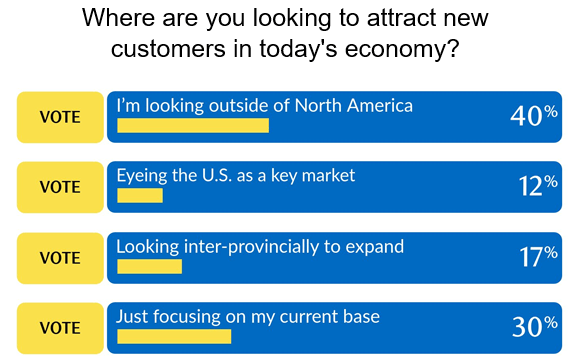TLDR
-
If existing markets have become too difficult to reach given the current trade environment, it may be time to explore new markets. This is called market development.
-
Identifying your ideal customer and studying lookalike markets can help you determine where it makes sense to expand.
-
Evaluating costs, capacity and risk through scenario planning allows you to create a move-forward plan.
-
Funding and support options exist: Leverage resources to enter new markets with confidence.
Small and medium-sized enterprises (SMEs) in Canada are facing significant challenges due to a complex and fast-moving economic landscape – one that includes tariffs, post-election policies and global uncertainty. Layer on digital transformation, such as AI and automation, and the game is changing for many businesses.
But amid these shifts lies the potential for progress. The Canadian government, for instance, has tabled a bill to eliminate federal interprovincial trade barriers and premiers appear to be supportive so far. To help make it easier for Canadian companies to do business internationally, the government is also deepening its economic partnership with the European Union (EU) and intensifying its trade activities in the Indo-Pacific region. What’s more, the drive to “buy Canadian” could provide new opportunities for domestic businesses – greater activity at home may blunt the effects of slower international sales.
There’s also room for individual businesses to create their own opportunity. If you’re experiencing some bottlenecks reaching or attracting customers due to today’s economy, it might be time to think about expanding your audience so that you’re not as dependent on your existing base.
This is called Market Development (see table below), and it involves selling your current products or services to new customer segments. This could mean entering a new region, targeting a different demographic or expanding into a related industry.
While it’s a sound strategy, you may be wondering: where do you start? Is there opportunity for your business in a new market? Do you have the resources and budget to effectively market to this new group?

Market Penetration: existing product to existing market
Product Development: new product to existing market
Market Development: existing product to new market
Diversification: new product to new market
Market Development: Taking the next step for your business
If your existing markets may have become too difficult to reach given the current trade environment, the following five steps can help you evaluate if your business is ready to take that next step.
Identify your ideal customer
To get started, take a close look at your current top-performing customers. What common traits do they share? If you’re running a B2C business, look at the demographics, income and behaviors of your best customers. If your business is B2B, consider the industry, size and geography of your most profitable and reliable client base.
Then, explore lookalike audiences in other markets. Tools like Google Trends, Statistics Canada or industry research can help you assess the potential size and value of a new market. As you home in on attractive markets, be sure to evaluate existing competition in that space – are they well established, or is there a gap you can fill? If there is competition, think about whether you can offer something different, faster or better.
Determine what it takes to reach that customer
What would it cost to acquire new customers in this market? Here are some questions to ask yourself:
-
Do you need to spend money on advertising or partnership costs?
-
How will you account for additional shipping fees?
-
Will your pricing resonate in this new market? Or would you need to adjust it to be competitive?
-
Are there any legal or logistical hurdles, such as language requirements, international duties or interprovincial taxes to consider?
-
Are there packaging, labeling or storage changes you’ll need to build into your new market plan?
If you’re feeling the impact of tariffs, you’re far from alone. RBC clients have shared how tariffs are affecting their businesses. In fact, a recent informal RBC poll shared almost 70% are looking to expand into other markets.

-
I’m looking outside of North America: 40%
-
Eyeing the U.S. as a key market: 12%
-
Looking inter-provincially to expand: 17%
-
Just focusing on my current base: 30%
Evaluate your capacity
With change often comes effort. So, as you assess a potential move into new markets, it’s worth taking stock of your bandwidth: Do you have capacity to produce more, or to change your operations?
Take some time to determine what kind of capacity and commitment it would take to enter a new market. Depending on your product and the market(s) you’re eyeing, it could be simply a change in processes. Alternatively, it could be a big investment that requires new equipment, storage space or inventory.
If it’s looking like considerable effort ahead, evaluate how digital tools may ease your workload. Could automation, AI or CRM systems help you do more with less?
Balance the risk and reward
Now is a good time to crunch some numbers and answer a key question: what is the potential revenue you could realize from a new market(s)?
Be sure to use conservative, realistic estimates as you go through the following steps:
-
Compare your potential revenue with anticipated costs from marketing and operational changes
-
Assess the timeline and estimate when you’re likely to see a return
-
Is there both short-term and long-term upside? Can you weather a slow ramp up if the long-term growth is expected to be meaningful?
-
Consider the risks and determine if entering a new market might distract you from your core operations. Is there a risk such a move would stretch your team too thin?
-
Build scenarios to assess the risks, requirements and potential outcomes of entering new markets. Tune into the Incorporating Scenario Planning webinar for some tips on creating and planning for ‘what-if’ scenarios
5 min read: 5 Ways Grants Can Help Grow Your Business in 2025 – My Money Matters
Consider funding and support options
As a business owner facing an uncertain economy and a rocky trade environment, you’re far from alone. The good news? This means there are several channels that can support you – from established trade programs to new resources created specifically to help SMEs navigate today’s landscape.
-
Government of Canada: The Government of Canada offers funding for certain international initiatives and resources to guide new market entry.
-
BDC: BDC offers resources and toolkits to help enter international markets.
-
Export Development Canada (EDC): EDC’s financing and insurance solutions are designed to support Canadian companies manage risk and seize new global opportunities.
-
Trade Accelerator Program (TAP): TAP is a hands-on international trade workshop designed to help Canadian businesses grow internationally.
-
RBC Trade Hub: The Trade Hub offers insights on how established Canadian businesses can respond to U.S. tariffs.
RBC is here to support small- and medium-sized businesses navigate through the current economic landscape. The new Tariffs Navigator for Business offers comprehensive FAQs, links to government resources, tips for responding to today’s dynamic economy and more.






